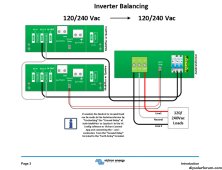I may have thought at one point the third pole was a 28A breaker for neutral, but it is a shunt trip which throws the 32A or 100A breaker.
It would be possible to have a current sensor (implement electronic circuit breaker) in which case we would want to know the overload/trip characteristics. Simply a thermostat seems more likely. 24V so there is a power supply in there.
If I was the designer I'd be nervous about allowing 200A on neutral protected only by temperature sensor. Inner windings and wires could get quite hot waiting for the thermal delay getting temperature sensor hot. Single inverter wouldn't be a problem, but about ten, 5kVA inverters would be. Considering fast trip would only be by 100A breakers (about 500A at 240V for magnetic instantaneous trip, slower thermal otherwise), neutral could carry way more for some limited time, given enough power driving.
It is a transformer. Both windings carry the same current. A single 14A breaker on one winding would protect center tap to 28A. Also want the shunt trip controlled by thermostat for over-temperature.
Enhance safety and efficiency with the Victron Autotransformer. Step up, step down, and balance your split phase output effortlessly.

www.currentconnected.com
I don't see any benefit to using it with stacked pair of 4kW 120V inverters except for greater instantaneous surge. It would decrease not increase the imbalanced 120V load capability.
Victron also offers isolation transformer, suggests to prevent galvanic corrosion of boats.
It is rated 230V, 32A. It has a soft-start resistor/switch (similar to precharge) so inrush of transformer doesn't trip breaker. It has 1:1.05 turns ratio.
Betcha' it is exactly the same transformer. When used with 120V per winding, it is nicely behaved, close to an ideal transformer. When used at 230V it is driven partly into saturation as is typical for transformers meant to be connected to grid, saving capital cost but drawing multiple amps of no-load current.
A couple of days ago my Isolation Transformer (IT) started acting up, popping one of the 16A breakers whenever some serious load was put on but still well under the maximum load. After a quick contact
www.cruisersforum.com




